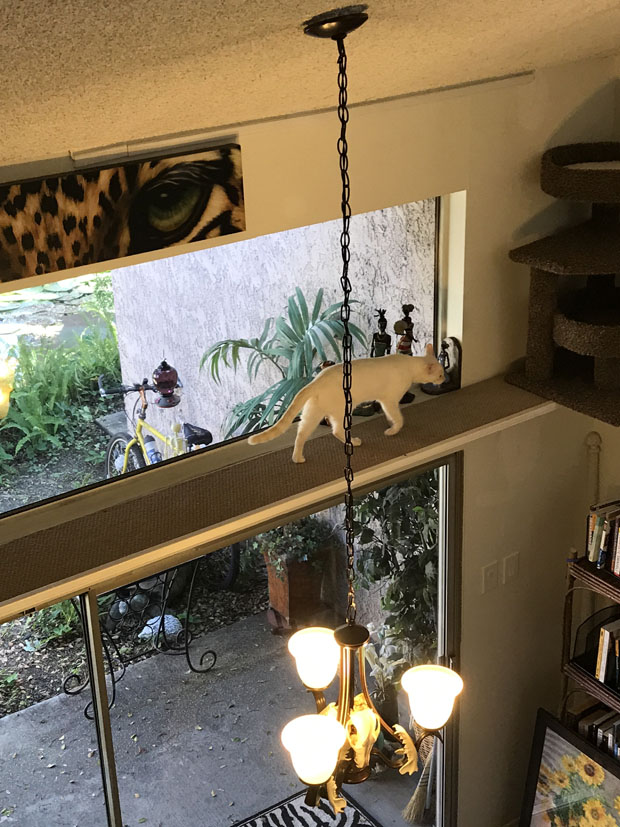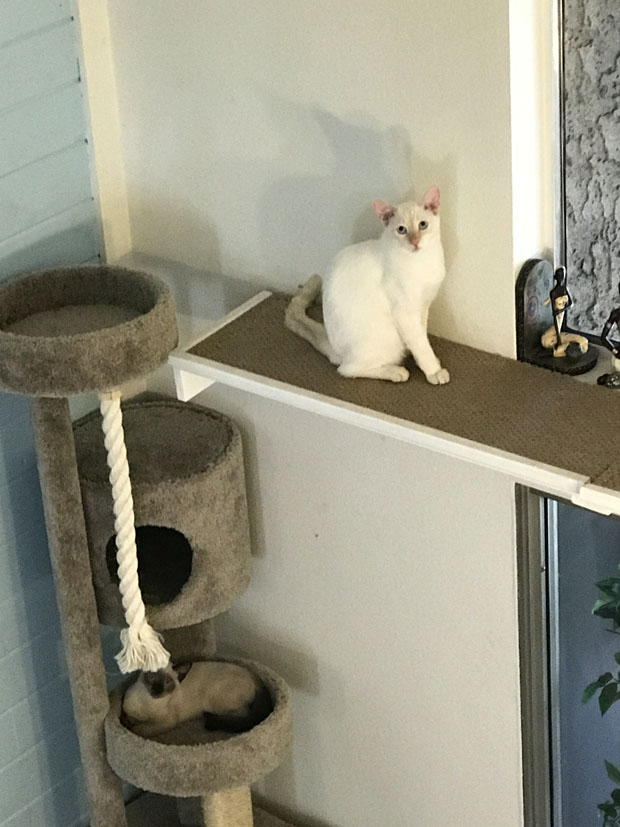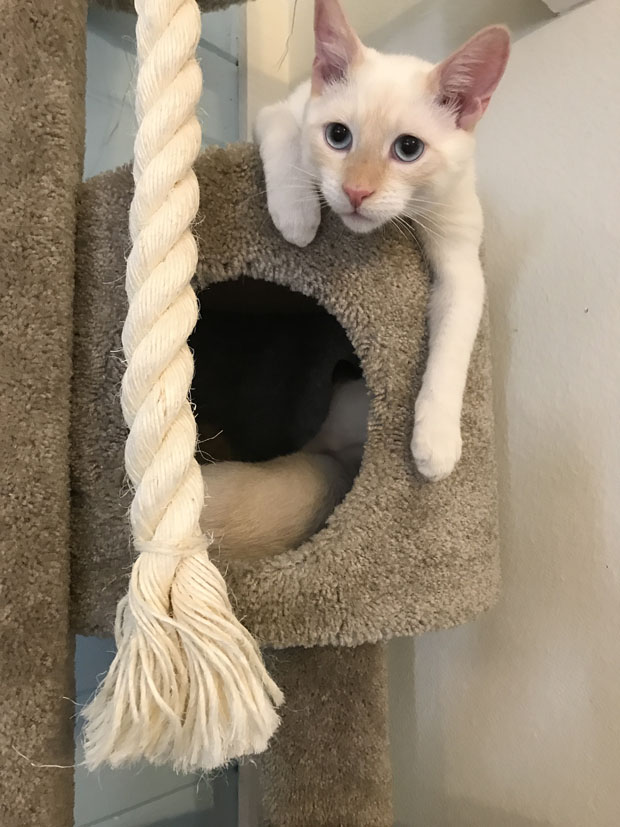
Loki enjoys a scenic stroll along the catwalk. Photos courtesy of Dr. Meredith Kennedy, DVM, Long Beach Animal Hospital.
Nature has designed the cat as a perfect predator: lightning-fast reflexes, the agility of a gymnast, the keen senses of a ninja, and the grace of a ballet dancer. Added to all of this is the intelligence of a solitary carnivore, with their keen awareness and exploration of their environments, prey seeking, attention to detail and alert vigilance. The perfect predator.
Then, we confine the cat to an apartment and provide an endless supply of high-quality food, and they never have to do anything. In a year or two, this finely tuned, powerful carnivore turns into an overweight couch potato, with very little to keep her keen predator’s mind stimulated.
You could allow the cat to be an indoor/outdoor cat in order to let them exercise their predatory instincts, but this comes with a tenfold (or greater) increase in the risks of disease, fleas, parasites, injury, fights, poisoning, getting hit by a car, attacked by dogs, eaten by coyotes and other misadventure. Neighbors may not appreciate your cat’s killing of birds, spraying their porch, using their garden as a litterbox, and howling outside their bedroom window.
Cats are much safer as indoor pets, and it will keep your neighbors happier. It’s also quite possible for them to live active, healthy lifestyles if you provide environmental enrichment.
Foster kittens Loki and Chai are now 7 months and 4 months old, respectively. They live as indoor cats in a 750-square-foot condo. At this age, they’re extremely active, yet not destructive, even though they’re living in a small space. Having two cats together is very helpful for their nuclear-level energy levels, since most of their time is spent playing with each other and chasing each other around. Meanwhile, they’re not shredding curtains, tearing plants apart, or clawing the toilet paper off the rolls.
They will need to stay active and mentally sharp as they grow up in an indoor environment, so there are several things we do to keep them engaged by trying to incorporate natural behaviors as much as possible.
Feeding time: Cats in the wild have to hunt for every single meal, so providing a predictable food supply removes the need for food-seeking behavior. The kittens do have a feeder with kibble they can eat at will, but the three meals a day of canned food provide opportunities for variety in the meals themselves as well as awareness of their environment and ability to exercise. These meals are not given at the same time every day, and not in the same location. Sometimes they’re fed downstairs, sometimes upstairs, sometimes out on the catwalk, sometimes next to the fireplace. They have to pay attention and run up or down the stairs when needed. It also constantly reinforces the act of coming when called.
Play and climbing: unlike dogs, cats can make use of upper parts of a living space that people can’t use. In our small condo, we have catwalks that extend out along the walls from the upper level, with kitty-climbing trees in each corner. They’re able to run up the stairs, out onto the catwalk, across the front of the condo and down the other side on a climbing tree, all without ever getting in our way or using space that’s used by people. They make frequent use of the catwalks, with epic chases and high-altitude acrobatics while staying out of the way (and providing endless entertainment for their human roommates!).
As an interesting observation on their development, Chai and Loki never used the catwalks or climbing trees until I physically lifted them up and placed them there. In a natural setting, kittens would be sticking very close to their mothers—it’s a jungle out there, full of dangerous places. The kittens have to stick with Mom and go where she goes in order to know what’s safe and what’s not. As hand-raised orphans, the kittens have spent most of their time on the floor and on chairs, which are part of the domain of human beings. (They’ve occasionally tried getting on the kitchen counter, but this has been strongly discouraged.) It wasn’t until their “mother figure” showed them it was okay to walk on the catwalk that they started doing it. They had not even been aware of its existence until then, although it had been there for weeks.

Shelf life means something else entirely to Loki, but it will indeed be a longer, happier life for him and Chai!

It’s important to provide places that appeal to the needs of cats. Here, Loki can climb, hide, swat at his rope “prey,” and stare at people.
Out and About: Loki and Chai are frequently taken for car rides (in their carriers), and often spend a shift at work at Long Beach Animal Hospital with me. It is a rare and special kind of job where one can take their cats to work with them! It provides a lot of contact with different people, different smells and different experiences, while remaining safe. They’re in practice to become good travelers, learning how to cope with changing environments and new stimuli. While riding in a car and being held and petted by co-workers isn’t exactly a natural setting, it does keep the kittens paying attention, and provides ongoing opportunities for socializing and engaging their natural curiosity. The next step will be harnesses and leashes (with a slow introduction) to increase their ability for traveling safely.
While it may not be very practical for most people to take their cats to work, there may be other chances to take housecats out for short trips, to a friend’s house or to engage in other similar activities. This has the added benefit of helping cats generally cope with the stress of a trip to the vet’s, the groomer’s or boarding. Cats who have had little or no experience with leaving their home environment tend to become extremely stressed when this happens. Stress can precipitate illness, so it’s worth helping pets cope with changing environments and stressful situations. Mental challenges and environmental enrichment can help housecats remain active and well exercised, reducing the risks of inactivity and obesity.
For more information on traveling with your cat, see last week’s The Vet Is In, “The Traveling Cat: A Tale of Two Kitties.”

